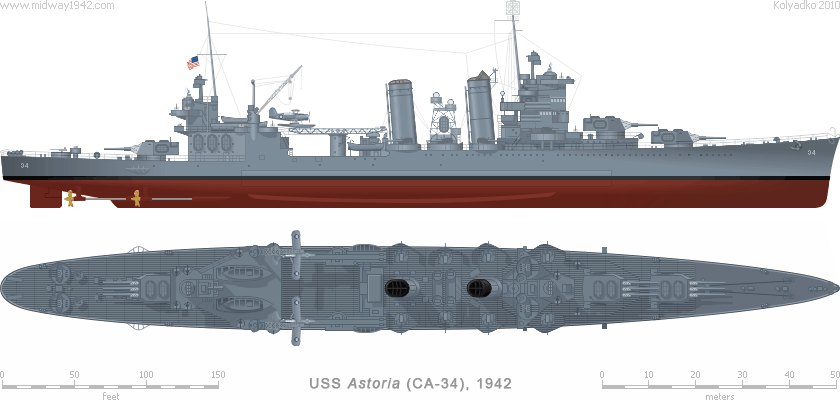
| New Orleans class | HEAVY CRUISERS | |

| Displacement: | 11,515 t (9,950 t Std) | Machinery: | 8 boilers, 4 shafts | Main Guns: | 3×3×8 in (203 mm)/55 | Main Belt: | 5-3 in | 127-76 mm | |||||||||
|---|---|---|---|---|---|---|---|---|---|---|---|---|---|---|---|---|---|
| Max Length: | 588 ft 2 in | 179.3 m | Max Power: | 107,000 hp | 78 698 kW | DP Guns: | 8×1×5 in (127 mm)/25 | Decks: | 2.3-1.3 in | 57-32 mm | |||||||
| Beam: | 61 ft 9 in | 18.8 m | Max Speed: | 32.7 kts | 60.56 km/h | AA Guns: | 4×4×1.1 in (28 mm)* | Barbettes: | 5 in | 127 mm | |||||||
| Draght: | 19 ft 5 in | 5.9 m | Range: | 14,000 nm | 25 928 km | AA Guns: | 12×1×.79 in (20 mm)* | Turrets: | 8-3 in | 203-76 mm | |||||||
| Complement: | 708 officers & enlisted | Bunkerage: | 3,269 t fuel oil | Aircraft: | 4 × SOC-1 Seagull | CTower: | 5 in | 127 mm | |||||||||
* Antiaircraft armament as during the Battle of Midway (June 1942).
Seven New Orleans class ships were the last U.S. heavy cruisers built under the restrictions of the Washington and London Naval Treaties, which limited the displacement of cruisers to 10,000 tons, and its main battery caliber to 8 in (203 mm).
Commissioned in 1934-1937 the ships turned out to be the most well-balanced design of the “treaty” heavy cruisers built for the U.S. Navy. All available weight within the 10,000 tons limit was to be used for increased protection, primarily for the magazines and ammo lifts. At the same time, armor protection everywhere else, over and around machinery, guns, important control stations all remained weak and capable at most of stopping 5 in (127 mm) destroyer shells; gun houses and command & control facilities being hard-pressed to even handle those.
The New Orleans class was the second class of US cruisers built without torpedo tubes due to wargaming results from the Naval War College which indicated that the torpedoes were unlikely to be fired from a cruiser, and more a liability than an asset. These academic results were contradicted many times during World War II when both Japanese and British cruisers used torpedoes rather effectively. All three New Orleans class ships lost during the war were sunk exactly by torpedoes fired from Japanese cruisers at the Battle of Savo Island on 9 August 1942.
Four New Orleans class cruisers took part in the Battle of Midway, three of them (CA-32 New Orleans, CA-36 Minneapolis, CA-44 Vincennes) as a part of Task Force 16 Cruiser Group (Task Group 16.2), one more (CA-34 Astoria) as a flagship of Task Force 17 Cruiser Group (Task Group 17.2).
| Ship | Builder | Laid Down | Launched | Commisioned | Fate | |||||||||||||
|---|---|---|---|---|---|---|---|---|---|---|---|---|---|---|---|---|---|---|
| CA-32 | New Orleans | U. S. Navy Yard. New York, NY | 14 | Mar | 1931 | 12 | Apr | 1933 | 15 | Feb | 1934 | Sold for scrap | 22 | Sep | 1959 | |||
| CA-34 | Astoria | U. S. Navy Yard. Puget Sound, WA | 1 | Sep | 1930 | 16 | Dec | 1933 | 28 | Apr | 1934 | Sunk in action | 9 | Aug | 1942 | |||
| CA-36 | Minneapolis | U. S. Navy Yard. Philadelphia, PA | 27 | Jun | 1931 | 6 | Sep | 1933 | 19 | May | 1934 | Sold for scrap | 14 | Aug | 1959 | |||
| CA-37 | Tuscaloosa | New York Shipbuilding Corp., NY | 3 | Sep | 1931 | 15 | Nov | 1933 | 17 | Aug | 1934 | Sold for scrap | 25 | Jun | 1959 | |||
| CA-38 | San Francisco | U. S. Navy Yard. Mare Island, CA | 9 | Sep | 1931 | 9 | Mar | 1933 | 10 | Feb | 1934 | Sold for scrap | 9 | Sep | 1959 | |||
| CA-39 | Quincy | Bethlehem Steel Corp. Quincy, MA | 15 | Nov | 1933 | 19 | Jun | 1935 | 9 | Jun | 1936 | Sunk in action | 9 | Aug | 1942 | |||
| CA-44 | Vincennes | Bethlehem Steel Corp. Quincy, MA | 2 | Jan | 1934 | 21 | May | 1936 | 24 | Feb | 1937 | Sunk in action | 9 | Aug | 1942 | |||